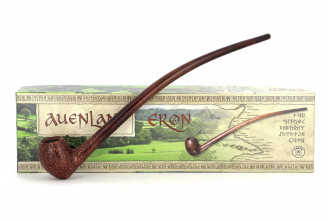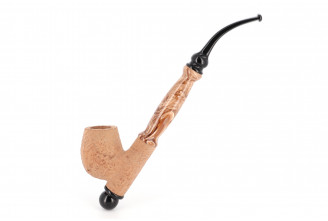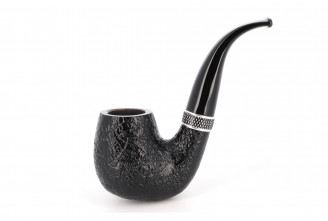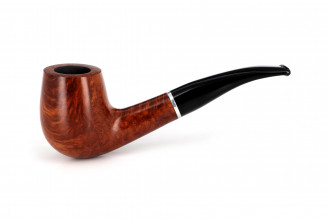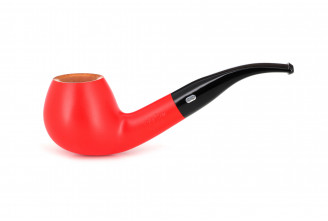
Waxed finish:
Pipes with a waxed finish are most of the time those that are commonly found on the market. Before 1917 and the beginning of sandblasted pipes, all the models had a waxed finish. Such a result is obtained by polishing the pipe with sandpaper with a thinner and thinner grain as the polishing process continues. A wax is then applied on the wood to put forward its grain.
So that the grain can stand out even more, some craftspeople use a special technique: a first layer of a dark color is applied on the wood, and then the pipe is polished once again. The color will therefore penetrate the softest parts of the wood. By using an abrasive agent, the color is removed on the hardest parts of the wood. The flames and grain on the wood stand out thanks to this contrast.
Why choosing a pipe with a waxed finish?
- This finish puts forward the grain of the wood and the briar.
- Waxed pipes have the classic finish: a traditional and timeless look.
Choose a pipe with a waxed finish
Lacquered finish:
To get a colorful pipe, craftspeople put a lacquer on the briar once the pipe has been polished. These pipes bring a touch of modernity and extravagance to a pipe smoker's collection. Some pipes have the same color (blue, red, yellow...), whereas others will have different colors and lacquers mixed together, and the result will therefore be unique for each pipe!
Why choosing a lacquered pipe?
- The lacquered finish allows to stand out. With such a pipe, no one will ever be able to tell you that smoking the pipe is only for old people! Indeed, colorful pipes break the image of traditional models.
- They bring a touch of modernity in a collection.
- Lacquered pipes are real fashion accessories. Over the years, we noticed a real evolution. After lacquered pipes with matte colors in 2016, people are now looking for white pipes. In 2020, black color had more success.
Natural finish:
"Natural" pipes are models with a briar that has been left natural as most as possible. Once polished, no lacquer or wax were applied on the wood. On these pipes, the briar has most of the time a very light color, which allows the grain of the wood to stand out. They are also very soft to the touch. Smokers like pipes with a natural finish thanks to the simple style of the latter and the beauty of the briar.
Why choosing a natural pipe?
- A pipe with a natural finish allows the magnificent grain of the wood to stand out.
- A natural finish allows the pipe to be very soft to the touch.
- The contrast between the wood of a light color and the black acrylic stem is perfect.
Choose a pipe with a natural finish
Sandblasted finish:
For many years, sandblasted pipes were models with a briar of good (but not excellent) quality, or with small imperfections on the briar. The sandblasting therefore allowed these imperfections not to be seen. However, the quality remains important, and a briar covered with flames and sandblasted will still be elegant.
Briar has not the same density everywhere in a same piece of root, and some parts are softer than others. For a sandblasted finish, the softest parts are therefore removed so that only the hardest are left. Contrary to what one might think, sandblasting will not hide the grain of the wood, but will allow it to stand out three-dimensionally.
The first sandblasted pipes appeared on the market more than a century ago. It is indeed in 1917 that Alfred Dunhill designed this finish. He was the first one to propose it with the Dunhill Shell Briar pipe collection.
Claire, La Pipe Rit
To make a sandblasted finish, craftspeople use a special machine that sends sand at high speed on the wood. Each pipe maker has their own way of doing it: some like a light sandblasting, whereas others will prefer a deep sandblasting. The following pictures that we shot in Butz-Choquin's factory in Saint-Claude will help you to understand better how sandblasting works.
Briars that have a "ring grain" that is formed during the growth of the tree (also called growth ring) will be perfect for a sandblasted finish. Indeed, if it is sometimes difficult to see them on a pipe with a waxed finish, these rings will stand out with a sandblasted finish, and are characterized by three-dimensional wavy lines all around the bowl.
Why choosing a sandblasted pipe?
- Sandblasted pipes will cool down more quickly compared to pipes with a smooth finish. It will indeed be easier for the heat to fade away because of the larger area.
- A sandblasted finish is less fragile than a pipe with a smooth finish, and everyday micro-scratches can not easily be seen on these pipes.
- A sandblasted finish allows a unique design, and smokers like to hold the irregular surface of the wood, very pleasant in the hand.
- A sandblasted pipe will also be more lightweight compared to a model with a smooth finish. Indeed, as we saw earlier, all the softest parts of the wood are removed.
Rusticated finish:
Unlike sandblasted pipes, the rusticated finish does not only consist in getting a pipe with an irregular surface. If the sandblasting process removes the softest parts of the briar, the rusticated finish allows a unique texture because the wood is carved with the help of special tools.
There are many ways to create such a finish. Each craftspeople and pipe maker indeed has their own technique and can give free rein to their imagination. Each pipe is therefore unique and looks like no other. In the same workshop, and depending on what the pipe makers wants to create, different results will be found.
Thanks to the rusticated finish, pipe brands can actually transform an ordinary pipe (with a mixed grain briar) into a magnificent model as pleasant to look as it is to hold in the hand.
Why choosing a rusticated pipe?
- Pipes with a rusticated finish are rare, and are also unique models (each pipe is worked depending on what the craftsman wants to create).
- A pipe can be totally or partially rusticated. No matter the result, these pipes are original and deserve to be in a pipe smoker's collection.
As you will have understood, each finish has many advantages. Waxed, lacquered, natural, sandblasted, rusticated... You just have to choose!
You need more information before choosing your next pipe? Do not hesitate to contact our team, whether by mail or by phone, we will be pleased to help you choose the pipe that fits you best!

Share this article to your favorite social networks!
































